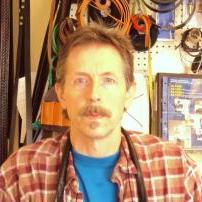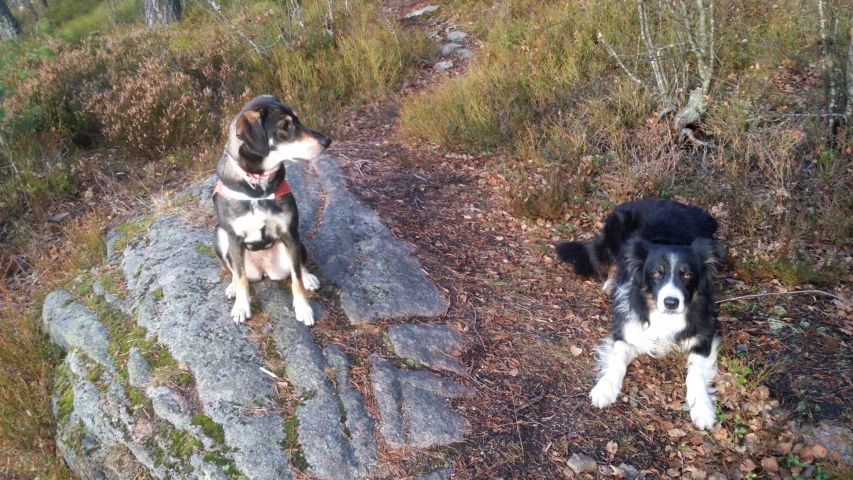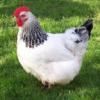-
Posts
1,591 -
Joined
-
Last visited
Content Type
Profiles
Forums
Events
Blogs
Gallery
Everything posted by Trox
-
Hello Hipounder, No my motor has the perfect speed for burnishing, any faster and it will create too much heat and burn the leather. When you use wax you need more heat. I have a different wheel for wax, made of a wood with less natural oil in, it runs much warmer. If I use this burnishing wheel without wax it burns my leather black (on the same motor). As I said before, there are as many differnt ways to burnish as there are leather workers, we all have our prefered way to do it. The same goes for the edge bevlers, what works for you might not work for me. Thank you. Trox
-
I have a cocobolo burnisher on a slow speed motor shaft, I prefer to use only water with it. That way I do not have to sand and clean it every time i want to use it. With use of wax or gum tragant it adds very quickly up a layer of fat that mess up the burnishing. All leather burnish differently too, some burnish best with canvas, some needs dye etc. On a motor burnisher it is important to have the right size grove to get a proper burnish. Trox
-
Hi SS, Welcome to the forum. A fast answer will be no. This is not a leather sewing machine. I do not know the subclass 21, however the Adler 199 is a home and semi industrial sewing machine for textiles. You will need a different machine for leather, preferable a triple feed industrial who is capable of sewing thick leather with thick threads. Adler, now Dürkopp Adler sell very fine machines for all kinds of material, the 199 is a old obsolete model. You can find information on old Adler machines on http://sew24.blogspot.no/p/downloads.html . However nothing on the class 199. Please read the pinned topics about this question, http://leatherworker.net/forum/index.php?showtopic=25239 . It is no quick answer to this question, I find no reason to repeat the pinned topics. You need to read it to learn, alternatively you have to trust the sewing machine salesman when you ask him/her this same question. You better read the pinned topics, to save time and money. Good luck Trox
-
The easy way to split 50 mm (two inch) wide leather strip on the bell skiver without any adjustments. If your skiver is set up for a normal 25 mm (one-inch) bevel skive, you can run a strap twice true the machine. Skive one side, turn it, and skive the other side. Then you will have a level split without messing up your skivers set up.
- 11 replies
-
Wiz is right about the bell skiver, it takes time to master it. However, it is no problem to split even strips of leather up to 50 mm wide. The knife is round, and so is the presser foot. It has the same radius as the knife, set at the same distance flat against the knife and it will act as a splitter. I use mine to skive and split thin skin/garment leather. When I make welts for my leather backpacks, I have to reduce the thickness of the leather to use it to make welts. I split garment leather strips about 30 to 40 mm wide on my bell knife skiver. I then roll them around a rubber core to make round welts. The machine is no replacement for the bench top splitter. When set up for garment leather, you have to change feed roll (a steel feed roll works better on veg tan) and do many adjustments to split/skive veg tan leather. In addition, do many test runs on scrap leather. When you learn to use the bell knife skiver, you can adjust it without doing many test runs. However, it takes time to get there. I leave my bell skiver set up for garment leather and use my bench top splitters for lap skives, and splitting belt and straps. You will see yourself what part of your work process that take the longest and what machine you need to speed things up. I need both splitters and the bell skiver because of the variety of leatherwork I do. If I have to skive some veg tan leather, I will just grab my skiving knife or round knife and do this easy skive. It has to be some yards of skiving before I will readjust my bell knife skiver for that job. Garment leather on the other hand is more time consuming to skive proper; it is jobs for the bell knife skiver regardless of the length of skive. Trox
- 11 replies
-
Happy Birthday to you Sylvia (It is the 18. October here in my place)
-
Cobra class 4 and limitid space. My friend from Sweden has his workshop on a boat with limited space. Here is how he solved the space problem. He bought a Ho Sing high-end mini servo for his Cobra class 4 and mounted it on the machine head. I have a similar motor on my 441, an Efka 1550. These mini servos are very strong and work best without a speed reducer. The Efka 1550 has a maximum power of 1800 watt and 8 Nm torque. They work best with a short flat belt like the one on the picture. On the new Dürkopp Adler 867 and 367 machines, they mount the Efka 1550 inside the machine head with direct drive on the main drive belt. This is an expensive pro motor, however no need for a table and speed reducers. Quality will last for a long time. You will get support on Skype videophone and software upgrade on your PC from Efka for free. In addition, it is a dream to use, needle position, and great slow speed control, programmable for all stitch pattern, functions and extras. Save space and in the long run $. I am very satisfied with mine. Trox Cobra class 4 and limitid space. My friend from Sweden has his workshop on a boat with limited space. Here is how he solved the space problem. He bought a Ho Sing high-end mini servo for his Cobra class 4 and mounted it on the machine head. I have a similar motor on my 441, an Efka 1550. These mini servos are very strong and work best without a speed reducer. The Efka 1550 has a maximum power of 1800 watt and 8 Nm torque. They work best with a short flat belt like the one on the picture. On the new Dürkopp Adler 867 and 367 machines, they mount the Efka 1550 inside the machine head with direct drive on the main drive belt. This is an expensive pro motor, however no need for a table and speed reducers. Quality will last for a long time. You will get support on Skype videophone and software upgrade on your PC from Efka for free. In addition, it is a dream to use, needle position, and great slow speed control, programmable for all stitch pattern, functions and extras. Save space and in the long run $. I am very satisfied with mine. Trox
-
Ok, we talk next week, have a nice trip. Trox
-

Adjustments To A 441 To Use Stirrup Plate
Trox replied to amuckart's topic in Leather Sewing Machines
Thank you Wiz, I have no experience with this liquid silicon. However, I remember when I spray painted cars, if any silicon mixed with the paint it made big ponds in the paint. If they had repaired the windshield with silicon, only a very small amount of silicon made big ponds in the paint. It did not matter how well you sanded the car body you had to use silicon remover to get rid of the stuff. That is the reason for my skepticism towards silicon. My Adler’s use the 328 needle, this needle are not running as hot as the 794. It gets smoking hot, the lube is absolutely necessary. I will try the silicon stuff, I to be using the white machine oil. Thanks Trox -
By the way, I think that red button should be used as a reverse button. (I am not talking about the knee switch) The seller told us it was a emergency stop button, I do not think he knew because it was not in use. You have a solenoid for the reverse and this button can be attached to it true the motor control. Check your manual, it is must likly a reverse button. Trox
-
Hi Marius, I told you it was a great machine. It was the best of its kind in high speed upholstery machines when new, and still sold for top dollar. I will visit to your workshop and have a look @ the knee switch. Call me and we will make an appointment. Happy pin sewing Trox
-

Adjustments To A 441 To Use Stirrup Plate
Trox replied to amuckart's topic in Leather Sewing Machines
Hei Leatherkind, Nice job! Now it will not skip any stitches when you use the stirup plate. What height are your feed dog att.? Do you think the plate still is strong enough for heavy use? How heigh is your machin`s foot lift (with original plate)? I have not had the time to modify my plate yet, been busy installing a new Efka motor and air foot lift on it. A question far off topic, what kind of thread lube are you using? I have been using ordenary Tandy neatsfoot oil, and having some stitch errors with this. I think the oil is making the polyester thread sticky and keeping it from making proper thread loops, and then again occasionally it skip stitches. I will try the silicon oil instead, however, that does not mix with dyes and paint. I have to do all coloring prior to sewing a projeckt. If you have any experience with this matter please let me know. Thanks Trox -
I am sorry, here is the link; http://www.quick-rotan.com/index.htm
-
Hei Marius, Here is the web site of Quick Rotan, seems like it is a part of Pfaff industrial. I do not remeber what numbers who was written on your motor. It is some Pdf downloads on this site, maybe one matches your motor. If not, send them an email and ask for the manual. Anyway you can read about the programing principles in them. Later. Good luck Trox
-
Hello Scott, This is a adjustment issue. The feed dog highest position should be in level with the needle plate. (The teeth of the feed dog should be in the same level as the needle plate, not over it). You can get manuals and support on this class on sew24.com ” the world of Dürkopp Adler parts” You ca read about your machine and ask questions to Mr. Thomas Brinkhoff, head of spare parts business Dürkopp Adler AG. He runs the blog there and is very helpful. Anyway, the 67`s leather subclasses (like yours) are all set up with a lowered feed dog adjustment. Together with a smooth vibrating and feeding foot the needle do most of the feeding job. This way the machine will not mark up your leather during sewing. You must also check the needle hook timing when you at it, and distance hook to needle (With the right needle size). Down load service manual in sew24.com. I think adjusting the feed dog height will take care of your ”bad turn” problem. http://sew24.blogspot.no/p/downloads.html Good luck Trox
-
I am sorry; I am not able to see this deal clearly. You must first trade and pick up the 211, and then again trade it for the Pfaff. Together with 300 $. (What subclass is the Pfaff, condition? A picture would tell me). You must calculate time and gasoline doing these trades. Then you will need a table for it (100-150$), a speed reducer (150$), a servo motor (150$), leather feet’s (50-100$), service/adjustments, spare parts and the time used to set it up. After purchasing, the next two weeks (must likely longer) will be waiting for parts, repairs and adjustments. When you all done, you will still only have an old sewing machine with a low trade in value. You will be spending about the same as the cost of a new Cobra/Cowboy machine, however without any warranty or customer service. You can use the process as learning or take an advice from someone who has been there before. If you are living in the US, you are lucky to have the member dealer’s close. Call them, if you do not have enough money ask for alternative funding, I am sure they will provide options for you. The cheapest looking deal might be the most expensive one. Just my two cents. Good luck Trox
-
Yes, thats right, original Pfaff parts are hand made in Germany. However the most common parts like hooks, feets and plates are avaiable from many aftermarket sources. The Pfaff machines are very well made, check the subclass number, like Bob says the H4 is the heaviest. However the H3 is also a strong machine. Like Wiz says, bring with you some thread and a piece of leather to test it. You can thread it and turn it by hand to test sew it. Check hook and needle bar for wear, good luck. Almost all industrial sewing machines are today made in China. Popular models are copied and produced by compeating brands. Bob sells very well made Chinese machines , the Cowboy sewing machine. Other good brands are Cobra, and Techsew. They are all Chinese clone machines that have good support. If you double your monney and add a couple of hundred you can get a brand new Cowboy or Cobra triple feed machine. For about 1500 $ you can buy a cylinder arm triple feed machine. These machine are sold by member dealers who stand behind there products, you can read all about them in this forum. Trox
-
Hi, Who is selling the 211-155? If it is a dealer, he should be able to time the machine first so it sews. This machine is a walking foot (triple feed) Strong machine. You should check why it do not pick up the bobbin thread (why it do not sew) I would time it in five minute, that make me wonder why they do not fix it prior to sale. You should bring somebody that knows sewing machines to the deal. You cannot be sure it is just an adjustment problem, (machines sews or are broken). I do not think it has reverse. No outside stitch length adjustment either. The Singer 11W is an antique machine, no walking foot. I think it should be an 111w-155, is this right? If so, that is also a triple feed machine, the forerunner to the above. Strong, but difficult stitch length adjustment (inside the machine head) and no reverse. A Pfaff 545 is a good machine; it had better be in working order. Because the part price is astronomical. You can buy a new Chinese clone for the same price as an original Pfaff needle plate. Otherwise, it is a very fine machine, similar to the 111w, but outside stitch adjustment and reverse. Built like a Swiss watch. A use a similar Pfaff, but with cylinder bed. Very happy with it. Good luck. Trox
-
Hi Scott, is your machine an Adler or a Chandler? I do not know the Chandler, however I think that is a Chinese Adler clone; am I right. I see that Chandler is a US company, however there products look Chinese to me. I am sure some other member can tell you more about this company. However, I can tell you about the German Adler class 67. The Adler 67 came in many subclasses, the Gk 373 heaviest subclass of them all. It has a bigger needle, bigger hand wheel and a high lift (12 mm by hand and 25 mm by foot). This machine would sew ¼ inch all day and night long without breaking anything. It will also sew up to ½ inch thick and an Nm 160 needle maximum. This according to the manual, it means that Adler warrants this performance, and I trust them. These machines are made for production works at least eight hours every day, how many hours are you using your machine per day? A ¼ inch is not that thick, however you are using the heaviest thread the machine is able to handle. Therefore, you are using it at its maximum all the time. You will not break the Adler; however, if it is a Chandler it can be an other story. You must always buy a machine that can do more than you will need; no machine is designed to perform on its maximum all the time. Your dealer is right these machines are designed for upholstery work; if you are going to sew holsters with thick thread get a heavy stitcher. Trox
-

Having Problems With Servo Motor Speed Control?
Trox replied to Cobra Tom's topic in Leather Sewing Machines
I am sorry Steve, I tought every EPS motor had the same metal adjustable actuator arm as my friends motor has. I now see why your motor is hard to modify. Thanks Trox -
Ha ha, thats a very good answer, Thank you.
-
Hi Grapejuice, I have not tried the Cowboy 7440. I know it is a copy of the Mitsubishi LU2-4400-BOB. I do not know what condition the Adler is in, is it an Adler or a Dürkopp Adler? (Adler become Dürkopp Adler in the beginning of 1990 `ties, this will help you to determinate the age of it) If the hook has to be changed, you must calculate part price and service in to your choice. Then support and parts prices will play a part too. Some dealers are selling the 267 new, but my Norwegian D. Adler dealer does not. Used sewing machine price in Norway is very low and not comparable with the rest of Europe. I cannot help you with the price example. The different feeds can be a jungle, and different names like walking foot and compound feed can mislead you. You need a triple feed machine, under, over and needle feed. Drop feed is only under feed, feeding with a feed dog alone, like your home machine. Compound feed means; two or three feeds working together, this can be used on machine with only double feed. (Like under and needle feed). The American term “walking foot” is legally used on every machine that has a foot that walks; even if this is, the machines only feed. Positive feed? I really do not know what that means, it tells me nothing. Be sure you to look at the machines data sheet to see what kind of feed it has. http://industrialsewmachine.com/webdoc3/feed.htm You can also read about different feeds and machines in this site. If you buy a German or Japanese machine, you will for sure get a very good sewing machine. How many hours a day will you use your machine determinates what quality you need to buy. Today all sewing machines are made in China anyway, even Japanese and German. Buying a Chinese clone machine you must do your research on support and parts available. What kind of motor is also important. If you post pictures of the used machine, it is easier to help you. Trox
-

Having Problems With Servo Motor Speed Control?
Trox replied to Cobra Tom's topic in Leather Sewing Machines
Dear Tom, No problem, that is right. I do not have the EPS motor myself, however my friend has one (see picture). This motor is also a 220v and has a different style actuator arm than the one in your picture, the arm is individual adjustable. On this one, you can install the mod. and adjust the light control for stop position afterward or vice versa. I thought every EPS motor had this style of actuator arm, but apparently not. My motor (who is a 220v without EPS) has this double plastic actuator arm, same as in your picture. I understood it was for an EPS and cut the extra light barrier plastic off. (I had too in order to install the mod) I see your point; with the double plastic arm, it will be difficult to install the mod. Your other 110v EPS motors do they all have this plastic actuators? Changing them to the aluminum style would allow installing the mod. It still requires a bit more adjustment to install the mod in the EPS motor. I would have locked the position (metal) arm with a piece of tape, when I installed the mod on the other side of the arm. You can take off the speed side of the arm without moving the other side. I do not know if these metal actuators are available for you, or why they not are installed in the 110v motors. Buy the way; I have installed my new Efka 1550 motor on my 441. The German dealer that sold me the drive sent me the wrong control box. They sent me a Dürkopp Adler control for the Adler 205-370 machine (and others DA machines). This control has only parameters for Adler machines and made it difficult to program for a Juki 441. I called Efka for support, they answered; no matter where you bought your motor, it is our job to help you until your machine is ready to sew. So they called me with Skype video call, went true all parameter until my machine sewed perfect. Thank you Manfred in Efka Germany The first thing he told me was to take off my speed reducer, he said that they had made these motor strong enough for every lockstitch machine without help of a gear reduction, up to 1800 watt and 8 Nm torque. The speed reducer will only disturb the control computer. He told me about what parameters I have to adjust if I need more power; I only use half of its capacity now. These motor work best if they are installed on the machine head with a short flat belt. They are so small that they can be hidden inside a machine head. On the new Dürkopp Adler 867 M type machine, they install this motor inside the head as a direct drive motor. The position head mounted on my hand wheel is only for calculating belt slippage. (On older motors they was used to terminate the needle position) Because of the wrong control, this setup was taking much longer than usual. With the right control, you can use a USB memory stick or a laptop to install the parameters. This is the reason I have not sent you any email, I have just finished setting it up. Trox -
-
Hi Jimbob, Is that the sound of your Harry Danielson or your Adler crying for help?







